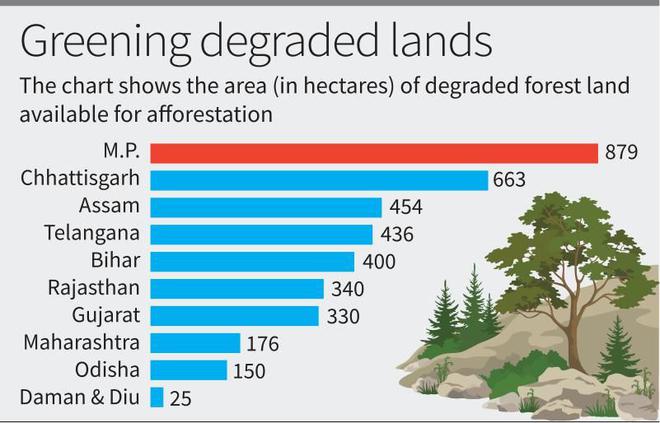Weeks after the Union Environment Ministry announced the rules for its Green Credit Programme (GCP), ten States have identified parcels of degraded forest land, amounting to about 3,853 hectares, that will be available for individuals, groups, public and private sector units to earn – and potentially trade – green credits.
A perusal of public documents by The Hindu suggests that Chhattisgarh and Madhya Pradesh alone account for up to 40% of the forest land made available.

Under the scheme, registered and approved entities can pay to finance afforestation projects in specific tracts of degraded forest and wasteland. The actual afforestation will be carried out by State forest departments. Two years after planting — and following an evaluation by the International Council of Forestry Research and Education (ICFRE), an autonomous body of the Environment Ministry — each planted tree could be worth one ‘green credit’.
These green credits can then be used by companies which have diverted forest land for non-forest purposes and razed thousands of trees to offset some of their obligations under India’s compensatory afforestation laws.
Also Read | What are the Centre’s initiatives for ‘Green Growth’ and energy transition?
Compensatory afforestation
These laws oblige any industry or institution that is given permission to raze forest and use that land for non-forestry purposes, to provide an equivalent amount of non-forest land to forest authorities and pay them to afforest that land. The condition is that such land be as close as possible to the forest tracts which have been razed. However, if such land is unavailable, twice the amount of ‘degraded’ forest land (usually land with very low tree density butwhich is officially marked as forest) may also be made available for compensatory afforestation. Additionally, companies must also compensate for the value of the forest ecosystem, called the ‘net present value’, which is lost due to the diversion of the forest land.
In several States, including Chhattisgarh and Madhya Pradesh where large tracts have been historically diverted for mining, getting contiguous non-forest land for compensatory afforestation is challenging. In fact, the Compensatory Afforestation Fund, whose corpus comes from the environmental compensation money paid by companies and which is to be used by States for afforesation, has thousands of crores of unspent money, simply because suitable land for regenerating forests, revenue or degraded, is unavailable.
Also Read | Centre moots ‘market’ scheme to promote sustainable living
Creating new land banks
Green credits for afforestation are a way to incentivise private investments in tree plantation. The philosophy of green credits flow in spirit from Prime Minister Narendra Modi’s repeated exhortations over the years to adopt ‘sustainable lifestyles’ and promote certain activities – afforestation, water conservation – as valuable ends in themselves.
However, assigning a monetary value to such credits is problematic, experts have said. Linking green credits to compensatory afforestation activities is even trickier as the programme in essence facilitates the creation of land banks that could be easily diverted to commercial entities and contribute to even greater levels of diversion of forest land. Compensatory forestation laws are essentially meant to disincentivise the appropriation of forest land for commercial ends, but the green credit scheme can potentially work towards the opposite end.
‘Does not absolve responsibility’
Bhanudas Pingale, who leads the programme at the ICFRE, told The Hindu that the scheme was currently in the ‘pilot stage’; so far, the applicants have been State and Central government entities.
“If the rules are read comprehensively, the green credit scheme will not absolve institutions of their responsibility to provide suitable land for compensation. Compensatory afforestation is not the only purpose of this scheme and the scheme is meant to encourage corporate social responsibility actions as well as regeneration. However we have only just started and may review provisions such as the time taken (currently two years) to approve a piece of land as having generated credits,” he said.







